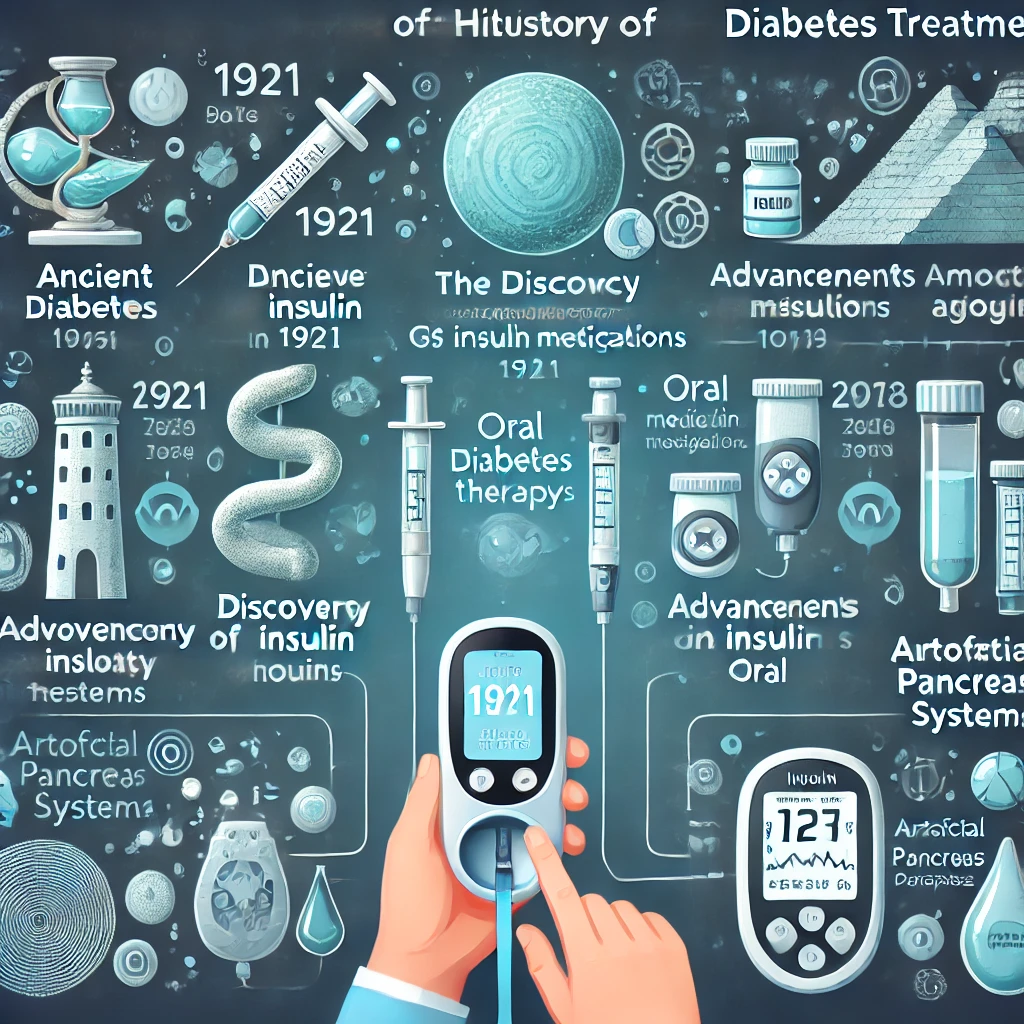The History of Diabetes Treatment: From Insulin to Modern Medicine
Introduction
Diabetes has been a recognized condition for thousands of years, but its treatment has evolved dramatically over time. From ancient herbal remedies to the revolutionary discovery of insulin and today’s advanced therapies, the progress in diabetes management has transformed the lives of millions. Understanding this journey is crucial in appreciating modern diabetes care and its future possibilities.
In this blog, we’ll explore the evolution of diabetes management, covering key milestones in diabetes treatment, from early historical approaches to cutting-edge therapies like GLP-1 agonists and continuous glucose monitoring
Historical Diabetes Remedies
Before insulin was discovered, diabetes was often a fatal condition. Ancient civilizations attempted various treatments based on observation and trial and error.
- Ancient Egypt (1500 BCE): The Ebers Papyrus described a condition resembling diabetes, recommending herbal mixtures and special diets.
- Ancient India & Greece (5th Century BCE): Physicians noted excessive urination (polyuria) and used dietary changes to manage symptoms.
- Medieval Europe & Asia: Herbal treatments, bloodletting, and restrictive diets were common, though ineffective.
These early treatments provided little relief, highlighting the urgent need for a scientific breakthrough.
The Discovery of Insulin and Its Impact
Development of Insulin Therapy
The most significant breakthrough in diabetes treatment came in the early 20th century. Before insulin, diabetes patients were often put on extremely low-carbohydrate diets, which extended life expectancy only slightly.
- 1869: Paul Langerhans discovered clusters of pancreatic cells, later named the Islets of Langerhans.
- 1889: Oskar Minkowski and Joseph von Mering established the connection between the pancreas and diabetes.
- 1921: Frederick Banting and Charles Best successfully extracted insulin from the pancreas of dogs.
- 1922: The first successful insulin injection was administered to a 14-year-old boy, Leonard Thompson, saving his life.
This discovery revolutionized diabetes care, turning a fatal disease into a manageable condition.
Milestones in Diabetes Treatment
Advancements in Diabetes Therapy
Over the decades, scientists and medical experts refined insulin therapy and introduced new treatment options.
- 1930s-1940s: Development of longer-acting insulin preparations to improve blood sugar control.
- 1950s-1960s: Discovery of oral diabetes medications, such as sulfonylureas, for Type 2 diabetes.
- 1980s: Introduction of human insulin, synthesized using recombinant DNA technology.
- 1990s: Development of insulin analogs for better blood sugar regulation.
- 2000s-Present: Innovations like continuous glucose monitoring (CGM), insulin pumps, and GLP-1 receptor agonists to improve diabetes management.
Modern Diabetes Medications
Today, diabetes treatment is more advanced than ever, with medications tailored to different needs.
Innovations in Diabetes Care
- Insulin Therapies: Rapid-acting, long-acting, and mixed insulins offer precise glucose control.
- Oral Medications: Metformin remains the first-line treatment for Type 2 diabetes.
- GLP-1 Agonists: These medications help regulate blood sugar and promote weight loss.
- SGLT2 Inhibitors: Improve blood sugar control and protect heart and kidney health.
- Artificial Pancreas Systems: Automated insulin delivery based on real-time glucose monitoring.
From Insulin to GLP-1 Agonists: The Future of Diabetes Treatment
With continuous advancements, the future of diabetes care is promising. Emerging treatments include:
- Stem Cell Therapy: Potential cure by regenerating insulin-producing cells.
- Gene Therapy: Correcting genetic defects causing diabetes.
- Artificial Intelligence in Diabetes Care: Personalized treatment plans and predictive analytics.
These developments could redefine how diabetes is managed in the coming years.
FAQs
When was insulin first used to treat diabetes?
Insulin was first used in 1922 to treat a diabetic patient, marking the beginning of effective diabetes management.
What were early diabetes treatments before insulin?
Early treatments included strict diets, herbal remedies, and experimental procedures like bloodletting, but they were largely ineffective.
What is the latest advancement in diabetes treatment?
Recent advances include GLP-1 agonists, SGLT2 inhibitors, and artificial pancreas systems that automate insulin delivery.
Can diabetes be cured?
Currently, there is no cure for diabetes, but research in stem cell and gene therapy holds promise for future treatments.
Conclusion
The journey from historical diabetes remedies to modern diabetes medications showcases the incredible progress in medical science. The discovery of insulin was a game-changer, and ongoing research continues to bring hope to millions of people living with diabetes.
As new innovations emerge, the future of diabetes management looks brighter than ever. Stay informed, consult healthcare professionals, and explore the latest advancements in diabetes therapy for better control and quality of life.
📢 Call to Action: Share this article to spread awareness about diabetes treatment advancements! If you have any questions or insights, drop a comment below! 🚀

Your writing creates colorful pictures in my mind. I can visualize every {detail you portray.
Your writing strikes a chord with me on a deep note. It’s like you’re writing for me!